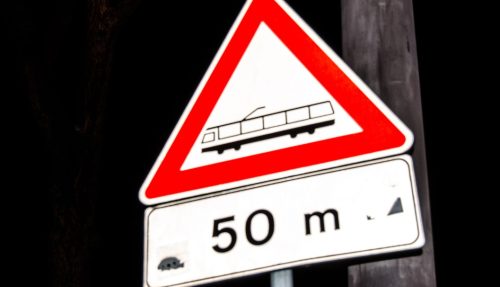Table of Contents
Understanding UK road signs is essential for all road users, from drivers to pedestrians.
Among the many signs seen on British roads, diamond-shaped traffic signs are less common but hold significant importance, particularly in areas where trams operate.
These signs provide regulatory instructions that must be followed to ensure safety and smooth traffic flow. However, many road users may not be aware of their purpose and who needs to obey them.
In this guide, we will explore what diamond-shaped traffic signs are, their purpose, where they can be found, and who should obey diamond shaped traffic signs in UK.
Additionally, we will discuss the consequences of ignoring these signs, how they differ from other UK road signs, and how learner drivers can prepare for questions related to them.
By the end of this article, you will have a clear understanding of diamond-shaped traffic signs and their role in UK road safety.
What Are Diamond Shaped Traffic Signs?

Diamond-shaped traffic signs in the UK are special regulatory signs primarily designed for tram drivers.
Unlike circular, triangular, or rectangular road signs, which provide instructions for general motorists, these signs are specifically used in areas where trams operate.
They help tram drivers follow speed limits, warnings, and operational rules to ensure passenger and pedestrian safety.
These signs often feature black symbols on a white or yellow background for clear visibility. Although these signs are primarily for tram operators, it is essential for all road users to recognise and understand their meanings.
Knowing these signs helps motorists, cyclists, and pedestrians navigate tram-heavy areas safely and avoid dangerous situations.
Why Diamond Shaped Traffic Signs Are Used?
Diamond-shaped traffic signs are used to regulate tram movement and enhance safety in areas where trams share space with other vehicles and pedestrians. Their primary purpose includes:
Ensuring Tram Safety and Regulation
- These signs provide essential instructions to tram drivers, ensuring they adhere to operational regulations.
- They help control tram speed, stops, and restricted areas.
Preventing Accidents Between Trams and Other Vehicles
- Trams move on fixed tracks, making it challenging to maneuver like cars or buses.
- Signs help prevent collisions by guiding trams and other road users.
Improving Traffic Flow in Tramway Areas
- By clearly marking tramways, these signs help separate tram traffic from other vehicles.
- They prevent unnecessary stops and confusion for drivers.
Increasing Awareness Among Other Road Users
- While primarily for tram drivers, motorists, cyclists, and pedestrians should also be aware of these signs.
- Recognising tramway zones prevents road users from unknowingly entering restricted areas.
Overall, diamond-shaped signs are crucial for maintaining order and safety in tram-operating zones across the UK.
Where Can You Find Diamond Shaped Traffic Signs in the UK?

Diamond-shaped traffic signs are strategically placed in areas where trams operate, ensuring tram drivers and other road users understand tramway regulations. Some of the most common locations include:
Tramway Intersections and Crossings
These signs mark where tram tracks intersect with roads, alerting motorists to yield to trams. They help prevent collisions at crossing points.
Dedicated Tram Lanes
Tram-only lanes are marked with signs like “Tramway Only” to keep other vehicles out. These lanes ensure the tram has a safe, dedicated route.
Tram Stops and Stations
Signs warn tram drivers of approaching stops, ensuring they slow down safely. Pedestrians and cyclists should also exercise caution in these areas.
City Centres with Tram Networks
Cities like Manchester, Edinburgh, and Nottingham use tram systems extensively. Diamond-shaped signs help regulate tram traffic and improve safety.
Being aware of these signs in these locations ensures that all road users can safely navigate tram-heavy areas.
Who Should Obey Diamond Shaped Traffic Signs in the UK?
Diamond-shaped traffic signs are legally binding for tram drivers and must be obeyed at all times.
These signs provide essential regulations for tram operation, such as:
- Speed limits that trams must follow.
- Priority rules at intersections and crossings.
- Warnings for approaching stops and restricted areas.
While these signs are specifically for trams, other road users should also be aware of them to ensure they do not interfere with tram operations.
Motorists, cyclists, and pedestrians must respect these signs to prevent accidents and unnecessary disruptions.
Ignoring these signs can lead to serious safety hazards and legal consequences for tram operators and other road users.
What Happens If You Ignore a Diamond Shaped Road Sign?

Ignoring a diamond-shaped road sign can result in:
Legal Consequences
- Tram operators who fail to follow these signs may face penalties, fines, or disciplinary actions.
- Other road users who disregard tramway warnings could be fined or penalised for obstructing tram operations.
Increased Risk of Accidents
- Trams cannot swerve or stop quickly, meaning collisions are likely if signs are ignored.
- Pedestrians and cyclists crossing tram lanes risk serious injury.
Traffic Disruptions
- Ignoring tramway-only signs may lead to vehicles blocking tram tracks, causing major delays.
- Cities with busy tram networks rely on these signs to keep traffic flowing smoothly.
Being aware of diamond-shaped signs ensures a safer environment for everyone on UK roads.
How Do Diamond Shaped Signs Differ from Other UK Road Signs?
Diamond-shaped traffic signs are unique compared to other road signs in the UK because they are primarily used for tram regulations.
Unlike circular, triangular, or rectangular signs, which apply to all road users, diamond-shaped signs are specific to tram drivers.
However, understanding their differences is crucial for all motorists, cyclists, and pedestrians to ensure road safety. The key differences between Diamond-Shaped Signs and other UK road signs are:
1. Shape and Purpose
- Diamond-Shaped Signs: Used exclusively for trams, regulating tram movement, speed, and stops.
- Circular Signs: Indicate mandatory instructions (e.g., speed limits).
- Triangular Signs: Warn about potential hazards (e.g., pedestrian crossings, slippery roads).
- Rectangular Signs: Provide information or directions (e.g., bus lane rules, parking instructions).
2. Road Users They Apply To
- Diamond signs are only applicable to tram drivers, but motorists should also be aware of them.
- Other UK road signs apply to all road users, including pedestrians, cyclists, and vehicle drivers.
3. Location and Placement
- Diamond-shaped signs are typically found near tramways, tram stops, and tram intersections.
- Other road signs are placed on motorways, urban roads, and highways to guide general traffic.
Understanding these differences ensures all road users navigate tram areas safely and avoid potential accidents or traffic violations.
What Are the Most Common Diamond Shaped Traffic Signs in the UK?

There are several diamond-shaped traffic signs used across the UK, primarily for tram regulations.
Recognising these signs is essential for tram drivers and other road users who navigate areas where trams operate.
Common Diamond-Shaped Signs and Their Meanings:
1. Tramway Only
- This sign indicates that only trams are allowed in a specific lane or road section.
- Motorists, cyclists, and pedestrians must not enter these areas to avoid accidents.
2. Tram Speed Limit
- Specifies the maximum speed limit for trams in a designated area.
- Ensures safe and controlled tram operation, especially in busy urban locations.
3. Give Way to Trams
- Instructs motorists to yield to approaching trams at crossings and junctions.
- Helps prevent collisions between trams and other road users.
4. Tram Stop Ahead
- Warns tram drivers about an upcoming stop, allowing them to reduce speed safely.
- Helps passengers prepare to board or exit the tram.
5. End of Tramway
- Indicates the end of a tram lane, where trams must merge into standard traffic lanes.
- Helps both tram drivers and motorists adjust their driving accordingly.
By understanding these common signs, road users can better navigate tram-heavy areas and ensure safer travel for everyone.
How Can Learner Drivers Prepare for Questions on Diamond Signs?
Learner drivers preparing for their UK driving theory test must familiarise themselves with diamond-shaped traffic signs, even though they primarily apply to trams.
Understanding these signs is crucial for road safety awareness and passing the theory exam.
Tips for Preparing for Diamond-Shaped Traffic Signs Questions
- Study the UK Highway Code: Focus on the tram-related section of the Highway Code to understand diamond-shaped signs.
- Take Online Mock Tests: Practice UK road signs, including diamond signs, through online mock tests to improve recognition.
- Observe Road Signs During Driving Lessons: Pay attention to diamond-shaped signs in tram areas during driving lessons for practical understanding.
- Use Road Sign Flashcards: Create flashcards to visually memorize the meanings and functions of diamond-shaped signs.
- Watch Video Tutorials: Watch online tutorials that showcase real-world examples of tram-related road signs in action.
By following these steps, learner drivers can confidently answer theory test questions related to diamond-shaped traffic signs and improve their overall road safety awareness.
Do Other Road Users Need to Be Aware of Diamond Shaped Signs?

Yes, while diamond-shaped traffic signs are specifically for tram drivers, it is crucial for other road users to understand them as well.
Trams operate in shared spaces with cars, cyclists, and pedestrians, meaning that being aware of these signs prevents accidents and confusion.
Motorists must respect tram-only lanes and give way when required, while pedestrians and cyclists should be cautious around tram crossings.
Recognising these signs helps all road users navigate tram-heavy areas safely and efficiently.
Ignoring these signs can result in serious road hazards, such as obstructing tramways or misjudging tram movements.
By understanding their meanings, everyone contributes to a safer transport environment in the UK.
How Can You Improve Your Understanding of UK Traffic Sign Regulations?

Having a strong understanding of UK traffic sign regulations helps both new and experienced drivers follow the rules and ensure road safety.
Since road signs constantly evolve, staying updated is important. The best ways to improve knowledge of UK Traffic Signs:
Read the Official UK Highway Code
The Highway Code is a comprehensive guide to all UK road signs, including diamond-shaped ones. It offers clear explanations and visuals for easy understanding.
Use Interactive Road Sign Apps
Mobile apps help users identify and memorise road signs with quizzes and real-life examples. They provide a fun and interactive way to learn.
Take Online Driving Theory Courses
Online courses from driving schools cover traffic signs in detail, offering practical guidance and mock tests. These help learners prepare effectively for the theory test.
Pay Attention to Road Signs While Driving
Observing road signs during your drives is a great way to learn. Drivers should pay attention to sign placement and their meaning.
Join Driving Awareness Workshops
Road safety organisations offer workshops that keep drivers informed about traffic regulations. These workshops also cover new sign changes and updates.
By using these resources, drivers can continuously improve their knowledge of UK traffic signs, making the roads safer for everyone.
Conclusion
Diamond-shaped traffic signs are vital for regulating tram operations and ensuring safety on UK roads.
While these signs are primarily intended for tram drivers, other road users must also be aware of them to prevent accidents and confusion.
Understanding where these signs are found, their meanings, and the consequences of ignoring them is crucial for all drivers, cyclists, and pedestrians.
By studying the UK Highway Code, practicing with mock driving theory tests, and being mindful of traffic regulations, road users can ensure they navigate tramway areas safely.
Increasing awareness of diamond-shaped traffic signs contributes to overall road safety and efficient transportation systems in the UK.
FAQs
Are diamond shaped traffic signs exclusive to the UK?
No, diamond-shaped signs are used globally, but their specific meanings can vary by country.
Can regular motorists be penalised for ignoring diamond signs?
Although they are primarily for tram drivers, ignoring them can cause accidents and road safety issues.
Are there any colour codes for diamond shaped traffic signs?
Yes, diamond-shaped signs typically feature a yellow background with black symbols for better visibility and recognition.
How do diamond shaped signs help in road safety?
These signs provide essential guidance for tram drivers, ensuring smooth traffic flow and preventing serious accidents.
Do cyclists and pedestrians need to understand diamond shaped signs?
Yes, especially in tram-heavy areas, as understanding these signs can help prevent potential hazards and accidents.
Where can I find a full list of UK traffic signs?
You can refer to the UK Highway Code or official government websites for an updated list of traffic signs and regulations.
Do diamond shaped signs appear in UK driving theory tests?
Yes, questions about diamond-shaped signs are often included in the UK driving theory exams, testing road sign knowledge.




